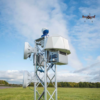A cutting-edge radar system that can detect drones small enough to fit in the palm of a hand will be tested at Ottawa’s airport starting this fall as aviation authorities around the world ramp up efforts to prevent the devices from disrupting air travel and wreaking economic havoc.
Qinetiq Canada, the Ottawa-based division of the British defence technology giant, is teaming up with NAV Canada, the locally headquartered not-for-profit firm that operates the country’s air traffic control systems, and the Ottawa International Airport Authority to pilot Qinetiq’s drone detection and tracking equipment. The 12-month pilot project – the first test of the technology at a Canadian civilian airport and the longest such trial so far – is expected to launch within the next month.
Qinetiq officials say Ottawa’s airport is an ideal location to find out how well the technology performs in a “noisy environment” filled with other airborne objects, including birds and planes, as well as other radar systems and sensors. They say the nation’s capital also offers the perfect proving ground to test the system’s mettle in weather conditions that range from steamy summer days to winter blizzards.
(Sponsored)

Family-owned Coke Canada Bottling investing to grow in Ottawa-Gatineau
Have you ever wondered where your favourite Coca-Cola products come from? Few people in know that over 300 popular beverages products, like Coca-Cola, Coke Zero, Fuze, Fanta, Monster Energy, A&W

Invest with confidence: Hydro Ottawa funds technical studies for business retrofits
For Ottawa businesses, the opportunity to improve building performance has never been greater. Energy retrofits can cut emissions, strengthen operations, extend the life of assets, reduce operating costs, and position
“It allows us to really put this thing through the paces,” says Patrick Keyes, a business development officer at Qinetiq Canada’s downtown Ottawa sales office. “We’re going to test its limits and push its limits.”
The high-tech radar system, known as Obsidian, was developed at the company’s R&D facilities in Malvern, England. The equipment has been on the market for a couple of years and is now being used around the world, but is not yet installed at any major airports in Canada.

“We don’t have to make too many cold calls,” Qinetiq Canada managing director Robert Aubé says. “There’s lots of demand.”
Aubé says Obsidian was designed specifically to detect even the smallest of drones using radar that recognizes the vibrations of a UAV motor or its propellers and distinguish between drones and other objects such as birds with a very high degree of accuracy.
He won’t name any of the firm’s customers, but says the technology could be used to alert authorities of incoming drones at high-security locations such as nuclear reactors or oil refineries like the facilities recently attacked in Saudi Arabia.
With the rise of high-profile incidents such as the reported drone sightings that caused hundreds of flights to be grounded at London’s Gatwick Airport last December and recent threats by climate change activists to use UAVs to shut down that city’s Heathrow Airport, aviation and security officials around the world are looking for solutions to tackle the increasingly common – and costly – problem.
In North America, 13 aviation and security officials – including Mark Laroche, the president and CEO of the Ottawa International Airport Authority – formed a blue-ribbon task force earlier this year to mitigate the threats posed by drones in and around airports.
Its final report, released this month, included recommendations on how to better identify and intercept drones around airports.
Aubé says drones have traditionally been problematic for old-school radar to spot because the devices are so small and can move relatively quickly. He says the Obsidian system will be able to detect drones in a 180-degree radius of the airport’s control tower up to a distance of about one kilometre and can pinpoint a UAV’s location to within about 10 centimetres.
“In all of the detection and mitigation strategies out there, 80 per cent of the problem is detecting (a drone) and knowing that it’s a drone and where it is,” Aubé explains. “With Obsidian, you get to know for sure that it is a drone and you get to know exactly where it is.”
The three partners plan to share data from the pilot project with other airports and security agencies. If all goes well, the technology could eventually be rolled out across the country, officials say.
“Our greatest concern is that the number of drones is growing exponentially,” says Rebecca Hickey, senior manager of public affairs at NAV Canada. “We’re really happy to see the Ottawa airport being proactive and seeing that this is a risk.”





